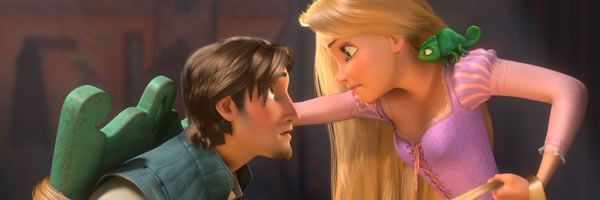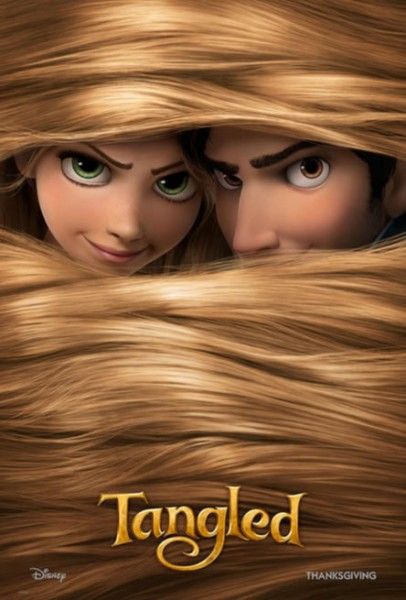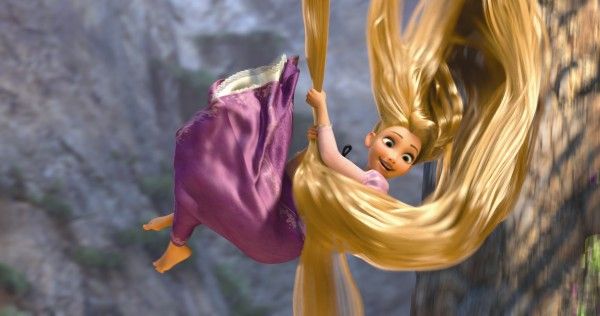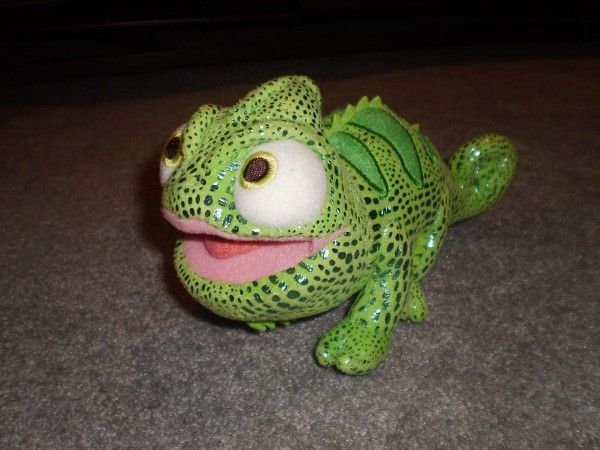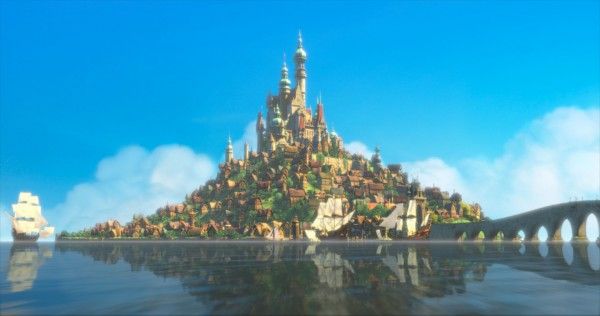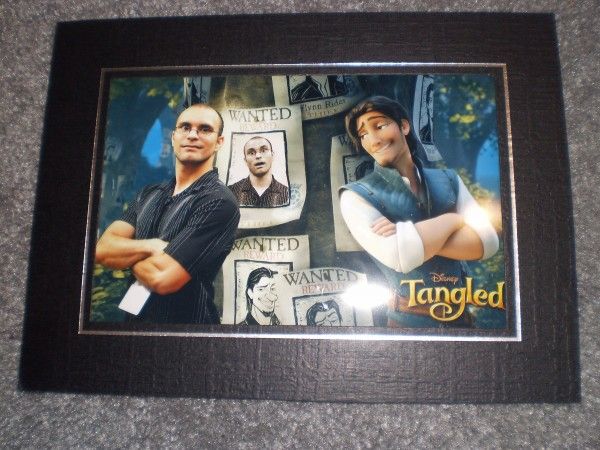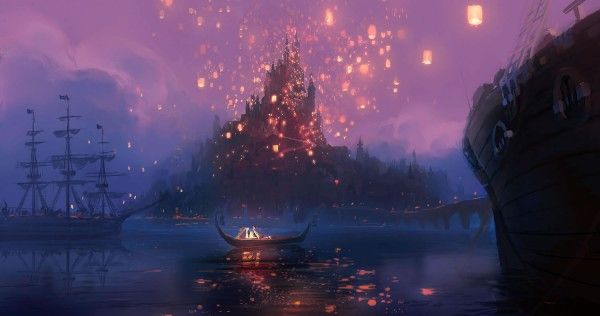The second part (part one is here) of my visit to Walt Disney Animation Studios continues, which focuses on the talented people that made Tangled and the process that it takes. During my press day at the studio we had a flurry of round-table interviews and John Lasseter, head of Disney’s animation wing, stopped by to speak for over 20 minutes. So join me after the break for highlights of what we discussed and a ton of behind-the-scenes information on Tangled.
Starting from where I left off on my last report, all the groups that had been split off reconvened in the theater where we had screened the film earlier that morning. We gathered for a discussion about dailies, which is a key ingredient to hammering down the fine details and gives the crew a place to give and receive feedback in a collaborative effort. This process is almost therapeutic in a way, as it breaks the norm for animators and storyboard artist and gets them out of their offices.
Joining us were directors Byron Howard and Nathan Greno, supervising animators John Khars and Clay Kaytis, and animator Zac Parrish. One of the major changes they made for Tangled was that instead of assigning a character to a single animator or group, they instead rotated the characters. This broke up the monotony of animating the same character over and over, and gave everyone the chance to work on a “character defining moment” for each.
Something else that was really interesting was that during dailies, animation supervisor Glen Keane used a cintique to draw over the frames that were up on the screen in real time. This allowed animators to take back examples of how the character animation should look like, instead of just having notes. Additionally, they really chiseled away at a lot of the superfluous actions and stuck to the core of the character. They showed a shot of Flynn Rider and his encounter with the thugs where they took out certain looks and animation to really accentuate the punch line.
After the discussion we were greeted by John Lasseter, who made an unscheduled visit to speak about the film and the changes Dr. Ed Catmull and he have made since they came over from the merger with Pixar. One of the first things that Lasseter spoke about were his three guiding principles to making a great film.
1) You have to tell a compelling story that keeps people on the edge of their seat. Where they can’t wait to see what happens next.
2) You populate that story with really memorable and appealing characters.
3) You put those stories and characters in a believable world. Not realistic, but believable in the world that you are telling.
-
These three principles were memorized and constantly referred back to by a number of Disney crew. The Pixar influence is strong, but this isn’t Pixar; it’s a different studio but ran in a similar direction. “[We] recognized that this studio would be very different than Pixar because a studio is not the building,” Lasseter said. “A studio is its artists. And this is a different group of artists and different tastes; this is Disney.”
“The one fundamental change that we made when we came in here was that we worked to make this studio a filmmaker driven studio, not an executive driven studio; which it used to be. Most every other studio except Pixar is an executive driven studio, but not this place. And the filmmaker is not just the directors. They are the key, but it’s the producers and heads of story, the supervising animators; the group that makes this film. That’s why I really empowered these guys to make this a film they want to see.”
He went on to state that he never lets a scene go into production until it is fantastic in story reel. This means that a lot of deleted scenes, well, they just don’t exist outside of story boards. This also means that they know the exact gag works well before they add money to really flesh it out, which helps make the scene that much better before it ever gets animated. Additionally, they watch story reel every 3-4 months, and collectively talk about it in a collaborative effort. The takeaway from all this is that even though there are more than 300 people working on the film, it is a group effort from beginning to end, which Pixar has shown is a winning formula and I think it shows in Tangled as well.
Lasseter also had a great story about how a key scene involving thousands of lanterns evolved, but I don’t want to drown you in Lasseter quotes so I will save that for the end. After Lasseter spoke, we broke for lunch and I was able to get my hands on one of my favorite characters from the film, which you can see below. However, our work wasn’t done just yet, as we then broke into our groups again and did roundtable interviews with the crew.
The first roundtable my group went to was with head of story Mark Kennedy and supervising animators Clay Kaytis and John Khars. They talked about how comedic actresses were an inspiration for Rapunzel’s character and that they had nine different versions of Rapunzel and five fully-rendered CG models before they settled on the final design, so it clearly wasn’t easy. Additionally, the characters storyline had a hurdle as well.
They had to find a balance with Rapunzel being locked away in a tower because otherwise it would become entirely too dark. So she has to have this joy to life that isn’t contained by the tower, and they took strides to make sure she is still happy and intelligent instead of depressed and dreary. They didn’t want the character to feel like her life was on hold until Flynn shows up. Part of that happiness is the art on the inside of the walls of the tower Rapunzel inhabits.
Claire Keane, Glen Keane’s daughter, actually designed all the art inside the tower, and it really helps show the maturation of Rapunzel with childish paintings at the bottom and constellations towards the top. The walls become more canvas than physical barrier for her.
Of the other characters, they mentioned that because they put so much emphasis on Flynn, he was the most interesting character for quite a while. They had to balance out the rest of the cast, and one of the highlights ended up being Mother Gothel, played by Tony award-winning actress Donna Murphy. They noted that they had a lot of trouble casting the role of Gothel early on but when Murphy came in, she nailed it. They were looking for the perfect blend of scary but also bubbly and she amazed them from the outset. Murphy also was an inspiration for much of the facial expressions for the actual character because she was so animated during her voice work.
Next up was Roy Conli, the producer of Tangled who is a pleasure to talk with. We pointed out one of the pieces of art of a monkey with a fortune teller’s hat that lined the walls of the story room we were sitting in. He elaborated that the art was from a scene where our heroes run into a gypsy and a fortune-telling monkey, but they just couldn’t get out of story-wise, so they had to cut it. However, you might see this in the special features and there is also a scene where the thugs read poetry inside the Snuggly Duckling that will likely be in there as well. However, as I mentioned previously, these will be in story board instead of fully-rendered CGI. Finally, when talking about inspirations and goals, Conli couldn’t help but express his love for Pinocchio and how he feels the best Disney films embrace the dark.
The third pairing featured co-directors Byron Howard and Nathan Greno, but because I had a one-on-two interview with the duo I have decided to add the highlights into the interview article I will be posting later this week. The fourth and final pairing we had access to were visual effects supervisor Steve Goldberg and art director Dave Goetz. As many have stated before, the animation on the film really pushed the limits of what was possible, and Goldberg certainly had his work cut out for him. His main job was to keep whatever technical wizardry was done behind the scenes as important in the grand scheme of the film with relation to how much time it would consume.
This led to tough choices, like keeping Mother Gothel’s large sleeves (she is very expressive with her arms, and that takes a lot of simulation) while nixing the guard’s capes. Additionally, Goldberg pointed out that this film really pushed things in terms of character interaction, as character contact (with themselves or others) is avoided in a majority of CG films because it is extremely complex to animate cloth-on-cloth interaction.
Meanwhile, Goetz highlighted the inspirations for the art direction, which took large cues for Cinderella and Pinocchio in terms of style and warmth of animation. Another interesting note was that nothing is too big or too tall (besides the tower), as even the kingdom feels more like a village. This is all in the effort to make the locations feel human sized, and not fantastical.
One last fun story about Rapunzel and the lengths they went through to get a feel for what 70 feet of hair was like involved the use of a football helmet. They drilled a hole into it and took about 70 feet of monofilament (fishing line) and fed that through. Then they proceeded to walk up and down the halls, which I’m sure was a hilarious sight and may even make the special features.
From there, we proceeded to mingle about and wait for our individual interviews as the day wound down. I have to say that they really put on a show and I learned way more about Tangled than I had thought I would. I love the special features of my DVDs and Blu-rays, so this was really like feeding me an IV of candy. As I mentioned earlier, I will have my interviews with Alan Menken, Zachary Levi, Many Moore, and directors Byron Howard and Nathan Greno posted throughout the week. As promised, below is the enormous quote from Lasseter on the inspiration for an integral part of the film.
“On my 20th wedding anniversary, with my lovely wife Nancy, we were down in Tahiti on Bora Bora. The guy at the resort we were at, head of food services, who was Italian. He marrifed an Indonesian woman, and he lived in Indonesia. He said, ‘I have something special for you.’ He brought out on our 20th wedding anniversary one of these lanterns and it was really big. He had us sign a little note to each other and we taped it to the top and he lit it and it was on the beach. It was very romantic, and it was dusk with the Tahitian sky. He said, ‘Now kiss and let it go.’ And when we let it go, that beautiful lantern just floated up into the sky and caught a little bit of wind and just drifted off. We had dinner there on the beach that night and we watched, for like 2 hours, this lantern float out until it was just this little warm spec. It looked like a star, and it was one of the most magical things that had ever happened to me. So, when this idea first came up, and we talked about something to do at this moment that was really special, I mentioned to these guys this idea. We got on the internet and we started looking around. We found these festivals where there isn’t just one of these, but thousands of theses in the sky. In Southeast Asia they do this lantern festival and we were so taken by this because we had never seen anything quite like this, so it became kind of an inspiration for this. And immediately as I saw this, I told them, ‘This would be so awesome in 3D!’”

